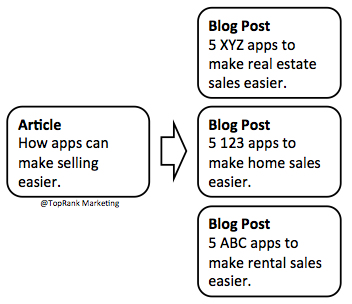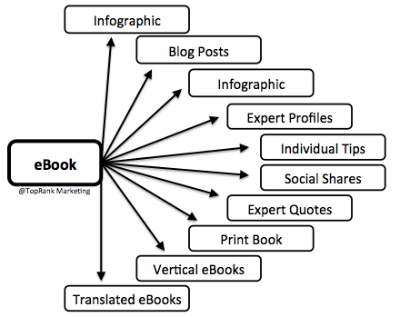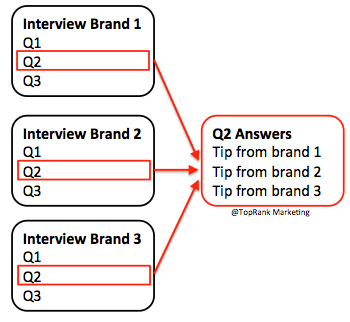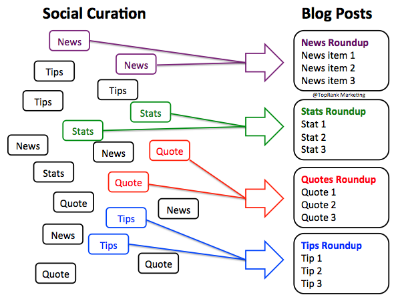
Ever have one of those dreams where you’re running a race and if you don’t win, you’ll turn into a big blue chicken? Hmm, maybe not.
How about running a race only to find you never actually finish because you’re on a treadmill? That’s how a lot of marketers feel about their Sophomore content marketing programs about now. The need for more and better content is never ending. Quarterly editorial plans make it feel like the end is near, but this isn’t a race. It’s a journey full of twists and turns, hits and misses. Maybe even a few blue chickens here and there.
The great thing about a journey is that if you pay attention and adapt, you can pick up tips to get even more value from the experience using the same or less resource investment. Working with the most minimal of marketing resources, I’ve picked up a few ways to get a lot more value out of content, especially through curation and repurposing.
To help you avoid the blue chicken and the treadmill dreams, here are my definitions of repurposing and curation as well as some examples you might find useful on your own content marketing journey.
Content Repurposing – Updating or changing content into a different form than the original to serve a different audience or the same audience differently.

Same Old, Similar. Anyone involved with content creation over a period of time is going to have a nice library of sorts to draw from when it comes to repurposing. The most common form of repurposing is to modify something that already exists to serve a different audience. For example, changing all instances in a blog post of a particular industry name to another and adding specific examples for that other industry. This type of repurposing isn’t always the best quality but if the person doing it has deep knowledge of the topic, it can work out.
Ironically, here is an example where a post about content repurposing that was republished with nominal customization of the headline and text:
- First – 5 Ways to Re-Purpose Content for Blog SEO
- Republished – Green Online Marketing: 5 Ways to Repurpose Content
Re-Purposonalized Content. Really great repurposing is a lot more like personalization, customization or localization. For example, creating an eBook (as we like to do) and then creating a supporting infographic, individual statistics and quote graphic tiles, social shares, blog posts, short video montage and even a print version of the eBook are all ways to provide the same information in different media formats.

With the Content Marketing World “Content Marketing Secrets” eBook, we published the eBook on Slideshare as well as long form interviews on the blog, individual profile images to Pinterest, individual tips images to Flickr, social shares on Twitter, LinkedIn, Google+ and Facebook. We didn’t end up doing an infographic or a print book, but certainly should have.
Modular Content Repurposing. Planned repurposing takes, well, planning. This is where you create a series of individual content pieces with the intention of pulling out parts to create something new. On their own, the individual content stands on it’s own and provides great value to readers. The remixed version does too and in many cases, can become even more popular.

One way to do this is to run a series of interviews with major brand practitioners or industry thought leaders. Make sure two or three questions ask for tactics and tips. After you run the series of interview posts (one a week or month), then you can take all the answers to one of the tactical questions and post it as a new article.
So, for 10 interviews, each thought leader may have given 3 tips for a particular thing. Now you have 30 tips from famous, trusted people (and brands) for your target audience to solve a tough problem as a new post.
For example, with the Social Media Marketing World 2014 conference eBook, we collected a good number of tips from industry thought leaders and major brands. Those tips were compiled into a PDF and uploaded to Slideshare. Then clusters of tips were collected for each of several different social media marketing topics and repurposed/published to the blog:
- Organic Facebook Marketing Tips From the Pros
- 5 LinkedIn Marketing Tips to Optimize Your Social Media Success
- 5 Must Read Perspectives on Social Media Marketing Strategy
Repurposing can come in many forms, from pulling the most interesting comments you’ve seen on your blog into the company newsletter (that’s actually curating and repurposing) to pulling together quotes from famous people into a Slideshare deck or infographic. In the end, the repurposed content needs to provide some level of unique value to people or it’s not worth doing.
Content Curation – Sourcing, annotating, organizing and sharing useful information for your target audience.
The thing about curation is that most marketers are focusing on curating other people’s content. Blog posts, tweets, images, videos, articles, presentations, reports, case studies, tips and how to’s, tools, and many more formats of content and media. That’s all fine and good, but everybody is doing that kind of curation. Examples of this type of curation include:

News Roundups – Ben from our team curates industry news on a daily basis to our @TopRank Twitter account and then he picks the best stories to be included in a Friday news blog post. This is a systematic curation that doesn’t take a lot of effort, but does take skill in picking good stories. Of course since this curated content is pretty modular, you can repurpose it beyond blog post listicles and create Slideshare decks, infographics or even explainer videos.
Another approach to curation involves curating your own content, whether it’s blog posts, social shares, comments or creations of any type: text, image, video, audio, interactive. Look through your web and social media analytics reports to find the most popular content. Find themes that you can tap into and cluster them into “best of posts” or simply categorize them as listlicles of listicles. Some examples we’ve done include:
- Top Online Marketing Posts for 2010 & 7 Year Blogging Birthday
- Top 10 Content Marketing Posts of 2011
- Top 10 Online Marketing Posts in 2012: Social, SEO & Content Marketing
- Top Content Marketing Posts of 2013
- 12 Killer Social Media & Content Marketing Blog Posts from 2013
You can curate many types of your own content and I think that’s an opportunity many companies miss as they mature in their own content marketing programs. The pressure to create new and more content distracts from appreciating the great content already created. So many visitors that are interested in what you have to say will never have seen every single article or social share your company has published, so why not make it easy and curate your best content?
There you go, over 1,000 words about content repurposing and curation. The number of combinations is worthy of multiple books, let alone blog posts on the topic – especially when you get into images, video and interactive applications. Hopefully I’ve planted the seeds of some clever repurposing and curation ideas for you. Heck, you might even do something with blue chickens.
What are some of the more clever repurposing and curation examples that you’ve seen on the web? How about examples of your own curation and repurposing?


